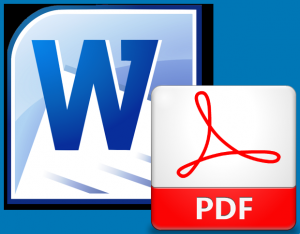 The following post was written by Susan Harkins for TechRepublic. Many of our clients ask for assistance working with .pdf documents and we thought this article was very informative so we decided to share it.
The following post was written by Susan Harkins for TechRepublic. Many of our clients ask for assistance working with .pdf documents and we thought this article was very informative so we decided to share it.
Learn how to use one of Word 2013’s most asked-for features: how to open and edit a PDF file in Word.
A lot of online forms, from craft instructions to IRS forms, are PDF documents. Often, you download them, print them out, and fill them out by hand because you can’t edit them. At least, that used to be the case. Now, you can open and edit a PDF in Word 2013 to fill in blanks or to make changes to the existing file. I can’t promise that the exchange will be exact — there are still features that just don’t convert from PDF to docx. But, the process is off to a good start and will probably improve in the future.
You can save a Word file to PDF format in Word 2007 and later. Word 2013 is the first version that allows you to open a PDF, edit it, and resave it as a PDF.
Using Word 2013, you can now open and edit a PDF file. You’ll do so as you would any other file. To open a PDF file using Word 2013, do the following:
1) Click the File menu and choose Open from the left pane. Or, click the Open icon on the Quick Access Toolbar (QAT) if you’ve added it (click the QAT toolbar drop-down and check Open to add it
2). At this point, you can use Recent Documents or your system’s folder structure to find the PDF you want to open. Word will display PDF files in its lists, so you won’t have to specify the PDF format to see those files
3) Select the file and click Open.
4) When Word displays the informational dialog click OK.
5) If Word displays the Protected View bar at the top of the document, click Enable Editing
Using Word 2013, you can open and edit the file as you would any other Word file (sort of). As I mentioned earlier, not every format and feature will transfer perfectly, so you’ll want to check the document carefully before saving your changes. I offer more specific advice below, but your own experiences will serve your best.
Save a PDF file
After editing the file, you can save the file as a Word document or as a PDF file. Your choice isn’t right or wrong; it will depend on how you intend to use the edited file. I recommend that you save the edited file as a Word document, even if you intend to distribute the file as a PDF.
When you save the file, Word will default to its format (.docx), so let’s walk through the steps necessary to save the edited file to the PDF format:
1) Click the File tab and choose Save As.
2) Choose a location for the new file.
3) When Word displays the Save As dialog, you’ll notice that it has default to its format.
4) From the Save As Type drop-down, choose PDF
5) Word will retain the document’s author, so you might want to delete or change that option.
6) Click Save.
Word 2013 converts editable text. That means some elements in the PDF won’t appear as you expected, nor will you be able to edit them. Some interactive PDF elements won’t display at all. Not all text will actually be text. Sometimes Word interprets elements as graphics. Even though the graphic appears to be text, Word treats it as a graphic. You won’t be able to edit these elements as text.
If you experience difficulties, save the PDF file as a Word .docx file. Then, close and reopen the .docx version. Interpreting the PDF elements as Word elements sometimes seems to improve the conversion.
This feature is still in its infancy, and you’ll find it works best with simple text documents. Editing is more limited in complex documents with lots of formatting and graphics. Also, remember, the more you change, the more you will displace the existing elements. It’s a limited feature, but it’s better than what we had before!
For more information on solutions for running your businesses’ technology more efficiently, visit our website or contact Megan Meisner at mmeisner@launchpadonline.com or 813 448-7100 x210.




